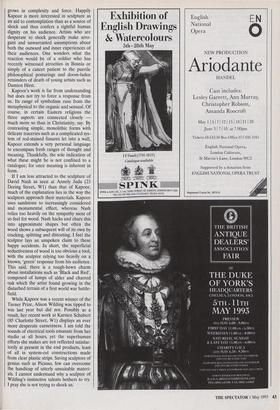Exhibitions
Anish Kapoor (Lisson Gallery, till 20 May) David Nash: at the Edge of the Forest (Annely Juda, till 19 June) Alison Wilding (Karsten Schubert, till 22 May)
Shock tactics
Giles Auty
It was considerate of Ian Dunlop to end his lengthy retirement from art criticism and point out the errors of our ways to us in his article 'Long live the new!' in last week's Spectator. The arguments Mr Dun- lop employs on behalf of shock and novelty in art are familiar enough to me but may
not be so, I suppose, to all readers. Howev- er, moved by the passion of Mr Dunlop's defence of the right to shock, I began to wonder whether one ought ever to feel out- rage at anything at all — even, say, at the latest huge explosion caused in London by the IRA.
If to shock is a virtue simply in itself, as Mr Dunlop avers, then perhaps the explo- sion could be regarded merely as a new form of artistic statement. Taking my cue from Mr Dunlop, who will dare assert that causing explosions should not be consid- ered a valid new form of art? Quite cer- tainly it is a much more fashionable means nowadays of trying to settle political argu- ments than anything so fuddy-duddy and traditional as civilised debate. By the same token, violent protest seems much more likely to appeal to the young who — so Mr Dunlop asserts — should not be asked to try to master traditional means of doing anything, lest it prove too testing for them. Indeed, if they can't be bothered with painting and drawing why should they trou- ble their heads about anything so old- fashioned as debating?
The three sculptors whose work 1 have been looking at this week are all concerned with matters beyond mere formal arrange- ments and appearances. Although relative- ly young, all three enjoy high reputations. The gallery spaces they show in are among the more spare and elegant in London. Indeed, it would be hard to imagine that the work of any of them could be seen to greater advantage elsewhere.
At Lisson Gallery (Bell Street, NW1), Anish Kapoor deals in his usual repertoire of sandstone and coloured fibreglass in a sculptural language which owes a debt to his Indian origins. It is a repertoire that Two untitled pieces and (right) 'In the Presence o Form II, 1993, by Anish Kapoor grows in complexity and force. Happily Kapoor is more interested in sculpture as an aid to contemplation than as a source of shock and thus confers a rightful human dignity on his audience. Artists who are desperate to shock generally make arro- gant and unwarranted assumptions about both the outward and inner experiences of their audiences. One wonders what the reaction would be of a soldier who has recently witnessed atrocities in Bosnia or simply of a cancer patient to the puerile philosophical posturings and doom-laden reminders of death of young artists such as Damien Hirst.
Kapoor's work is far from undemanding but does not try to force a response from us. Its range of symbolism runs from the metaphysical to the organic and sensual. Of course, in certain Eastern religions the three aspects are connected closely much more so than in Christianity, say. By contrasting simple, monolithic forms with delicate traceries such as a complicated sys- tem of red-stained fissures let into a wall, Kapoor extends a very personal language to encompass fresh ranges of thought and meaning. Thankfully, the sole indication of what these might be is not confined to a catalogue; for once meaning is inherent in form.
If I am less attracted to the sculpture of David Nash as seen at Annely Juda (23 Dering Street, W1) than that of Kapoor, much of the explanation lies in the way the sculptors approach their materials. Kapoor uses sandstone to increasingly considered and monumental effect, whereas Nash relies too heavily on the sympathy most of us feel for wood. Nash hacks and chars this into approximate shapes but often the wood shows a subsequent will of its own by cracking, splitting and distorting..I feel the sculptor lays an unspoken claim to these happy accidents. In short, the superficial seductiveness of wood is too obvious a tool, with the sculptor relying too heavily on a known, 'green' response from his audience. This said, there is a rough-hewn charm about installations such as `Black and Red', composed of lumps of alder and charred oak which the artist found growing in the disturbed terrain of a first world war battle- field.
While Kapoor was a recent winner of the Turner Prize, Alison Wilding was tipped to win last year but did not. Possibly as a result, her recent work at Karsten Schubert (85 Charlotte Street, W1) displays an ever more desperate earnestness. I am told the sounds of electrical tools emanate from her studio at all hours, yet the superhuman efforts she makes are not reflected satisfac- torily at present in the end products, least of all in system-cut constructions made from clear plastic strips. Saving sculptors of genius such as Picasso, few can overcome the handicap of utterly unsuitable materi- als. I cannot understand why a sculptor of Wilding's instinctive talents bothers to try. I pray she is not trying to shock us.



























































 Previous page
Previous page